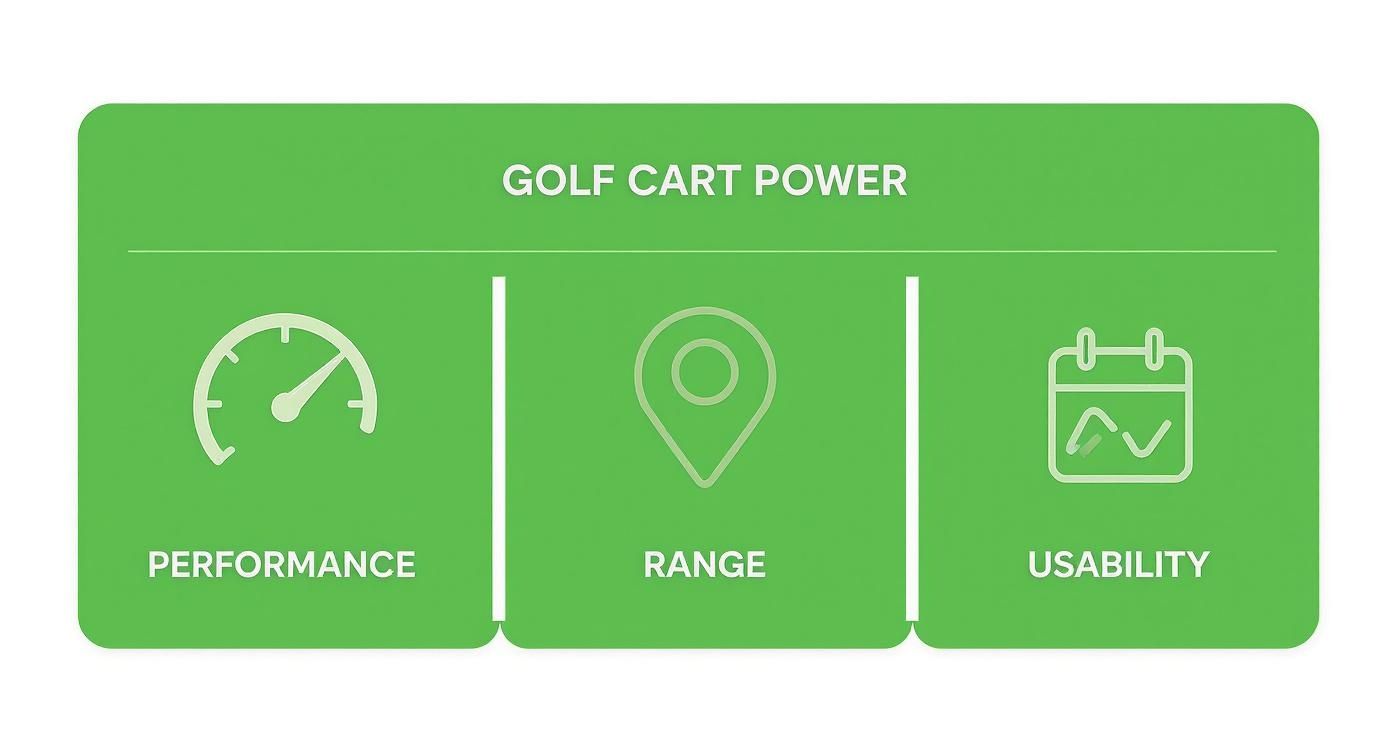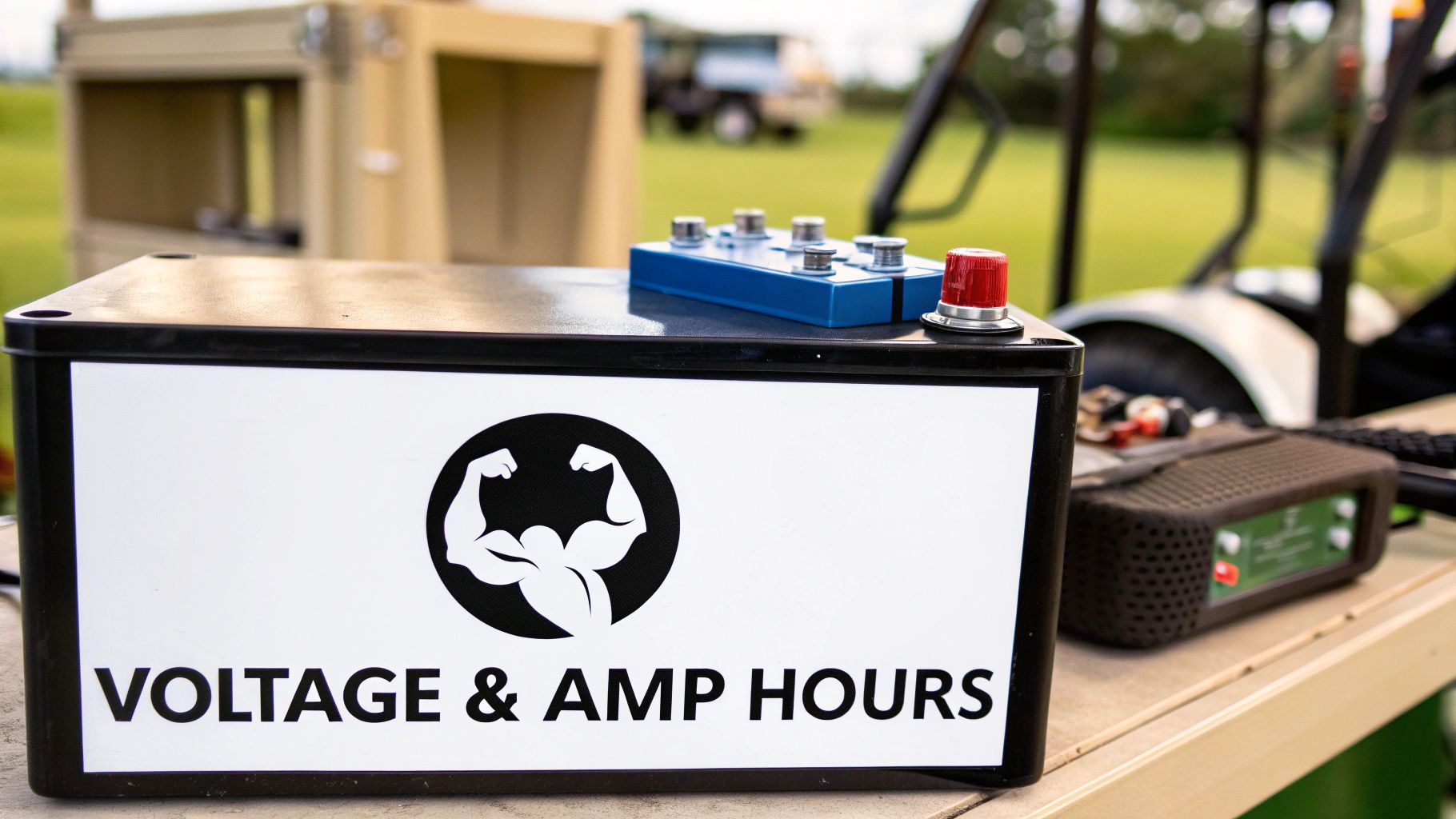An electric golf cart runs on rechargeable batteries, making it a quiet, clean alternative to the old gas-guzzlers. The battery system is really the heart of the machine, defining everything from its power and range to how long it’ll last you. You’ve got options, from traditional lead-acid to the newer lithium-ion technology.
The Engine Room of Your Electric Golf Cart
Let's talk about the heart of your electric golf cart: its battery system. This isn't just a simple power source; it's the core of your cart's personality. It dictates how it performs on the course, how practical it is for daily use, and even how it feels to drive around the neighborhood.
Think of the battery as the engine in a car. It controls everything from how fast you can zip up a steep hill to how long you can cruise before needing to "refuel."
Getting to know your battery is the first step to mastering your electric cart. The choice you make here will shape your entire ownership experience in a few key ways:
- Performance and Power: How does it accelerate? Can it tackle inclines without slowing to a crawl? The battery's tech and voltage directly impact its get-up-and-go.
- Total Range: How far can you actually go on a single charge? This is all about battery capacity, and it determines whether you’re good for 18 holes, 36, or just a quick spin around the block.
- Maintenance Demands: Are you going to be checking water levels every month, or is your system more of a "set it and forget it" solution?
- Overall Lifespan: How many years of solid, reliable service can you expect before you're looking at a pricey replacement?
This shift toward electric power is changing the game. The global golf cart market was valued at USD 1.71 billion in 2024, and the electric segment is on track to snag about 95.3% of the market share by 2025. People are catching on to the environmental and economic perks. You can dig into more stats on golf cart market growth over at maximizemarketresearch.com.
Choosing a battery is like choosing an engine. It’s not just about power; it’s about reliability, endurance, and how it fits your lifestyle.
Our goal here is to give you a solid foundation. We want you to feel confident as we dive into the two main technologies you’ll come across—classic lead-acid and modern lithium. Once you understand these options, you'll be ready to choose the right cart, maintain it properly, and get the most out of it for years to come.
Lead-Acid vs. Lithium: The Main Event
When it's time to choose the power source for your golf cart, you're really looking at two main contenders. It's a bit like deciding between a trusty, old-school pickup truck and a sleek, modern sports car. This decision is huge—it will define your cart's performance, how much work you have to put into it, and its long-term value.
First up, you've got lead-acid batteries. These are the traditional workhorses of the golf world. They've been powering carts for decades, they're reliable, and they come with a lower upfront cost. They get the job done without much fuss, making them a solid choice if you're on a tighter initial budget.
Then you have the challenger: lithium-ion batteries. Think of these as the sports cars of the battery world—they're lightweight, incredibly powerful, and built for the long haul. They represent a major leap forward in technology, offering some seriously compelling benefits that are shaking up the entire industry.
The Weight and Maintenance Difference
The first thing you'll notice is the massive difference in weight. A full set of lead-acid batteries can easily top 300 pounds, adding a ton of bulk to your cart. A single lithium battery that delivers the same power? It often weighs less than 100 pounds. That huge weight reduction makes a real difference in acceleration, handling, and overall efficiency, especially if you play on hilly courses.
Then there's the maintenance. Lead-acid batteries need regular TLC to perform well and last as long as they should.
- Watering: You'll have to pop the caps and top off the water levels in each cell with distilled water pretty regularly.
- Cleaning: The terminals are notorious for getting corroded, so they need a good cleaning every so often to keep a solid connection.
- Equalizing: From time to time, they need a special "equalization" charge to keep all the cells balanced.
Lithium batteries, on the other hand, are pretty much a "set it and forget it" deal. No water to check, no corrosion to scrub off. That alone saves you a ton of time and hassle over the life of your cart.
This infographic really drives home how these differences play out in the real world, affecting performance, range, and just how easy the cart is to own and operate.

As you can see, lithium’s lighter design and better chemistry give it a clear edge in performance and create a much more convenient experience for the owner.
Lead-Acid vs. Lithium-Ion Battery Showdown
To make it even clearer, let's put these two technologies head-to-head in a direct comparison. This table breaks down the key differences that matter most to a golf cart owner, from how long they last to how much work they require.
| Feature | Lead-Acid Batteries | Lithium-Ion Batteries |
|---|---|---|
| Lifespan | 4-6 years with proper maintenance | 10+ years, often outlasting the cart |
| Weight | Very heavy (often 300+ lbs total) | Very light (often under 100 lbs total) |
| Maintenance | Regular watering, cleaning, and equalizing | Virtually zero maintenance required |
| Charging Time | 8-10 hours for a full charge | 2-3 hours for a full charge |
| Upfront Cost | Lower initial investment | Higher initial investment |
| Long-Term Cost | Higher due to more frequent replacements | Lower due to extreme longevity |
| Performance | Power fades as the battery discharges | Consistent power output until fully discharged |
Looking at the big picture, while lead-acid gets you started for less, the long-term benefits of lithium—from its lifespan to its hands-off nature—often make it the smarter financial choice over time.
Lifespan and Total Cost of Ownership
While lead-acid batteries might seem cheaper at first glance, lithium batteries almost always come out on top when you look at the total cost of ownership. A well-cared-for set of lead-acid batteries might get you 4-6 years of use. A lithium battery, however, can easily last 10 years or more—it might even outlive the cart itself.
By lasting up to five times longer and requiring no maintenance, lithium batteries significantly reduce replacement costs and hassle over the lifetime of your golf cart.
This incredible longevity, paired with faster charging and consistent power delivery, is why lithium is becoming the go-to choice for so many cart owners. The numbers back it up: the lithium golf cart battery market was valued at USD 708.1 million in 2024 and is expected to explode to USD 2,500 million by 2035. That kind of growth shows a massive shift in what people want from their carts.
If you really want to geek out on the science behind it all, this detailed comparison of Lithium and Lead-Acid battery technologies for off-grid power systems is a great read. Even though it’s a different application, the core principles of battery performance and durability are the same. Ultimately, the right choice for you comes down to balancing your budget, what you need in terms of performance, and how much time you're willing to spend on maintenance.
Decoding Battery Voltage and Amp Hours

To really get a feel for your battery golf cart, you have to speak its language. The two most important terms in that language are Voltage (V) and Amp Hours (Ah). Getting a solid grip on these two numbers is the key to unlocking your cart's true potential, whether you're just cruising the neighborhood or planning a serious power upgrade.
Here’s a simple way to think about it: voltage is the muscle, while amp hours are the stamina.
What Is Voltage in a Golf Cart?
Voltage is basically the electrical pressure in your cart's system. In real-world terms, it’s the raw power that gets your cart up and moving. A higher voltage translates directly to more torque and better overall performance, especially when you need it the most.
Picture this: you're at the bottom of a steep hill. Voltage is what gives your cart the brute force to climb it without slowing to a frustrating crawl. It’s also what delivers that satisfying little kick of acceleration when you step on the pedal.
Most modern golf carts run on one of two common systems:
- 36V Systems: You'll often find these in older or more basic models. They're typically made up of six 6-volt batteries all wired together in a series.
- 48V Systems: This has become the standard for most new carts, offering a noticeable bump in both power and efficiency. These systems are usually built with six 8-volt batteries or four 12-volt batteries.
Understanding this setup is crucial. Your cart’s total voltage is just the sum of the individual batteries working as a team. This is why any battery upgrade must match your cart’s existing system voltage—get it wrong, and you risk frying the motor and controller.
Understanding Amp Hours and Your Range
If voltage is the muscle, then amp hours (Ah) represent the size of your fuel tank. This number tells you exactly how much energy your battery can store and, by extension, how far you can travel on a single charge. More amp hours mean more stamina for longer adventures.
For instance, a 100Ah battery can supply 100 amps of current for one hour before it's completely drained. This is the single metric that most directly impacts your cart's range, determining whether you can confidently play 18 holes, 36, or even more.
Think of it this way: Voltage gets you up the hill, but Amp Hours determine how many hills you can climb before you need to head back to the charger.
When you start comparing batteries, especially if you're looking at a lithium upgrade, you'll see a wide variety of Ah ratings. A higher capacity is always better for range, but it also comes with a bigger price tag. The trick is to balance how you typically use your cart with your budget to find that sweet spot for your battery golf cart.
How to Maximize Your Golf Cart Range

There's nothing worse than range anxiety cutting a great day on the course short. Squeezing every last bit of distance from your battery golf cart isn’t luck; it's about smart habits and knowing what drains your power. Think of it like a car's fuel economy—how you drive and what you're up against makes all the difference.
Several key factors are constantly working against your battery's charge. Steep hills, for instance, demand a huge surge of power, draining your battery far quicker than just cruising on a flat fairway. Every extra pound from passengers or gear also forces the motor to work harder, eating up more energy with every push of the pedal.
Even your driving style plays a huge part. Flooring it from a dead stop and slamming on the brakes is incredibly inefficient. Smooth, gradual acceleration and letting the cart coast to a stop are much kinder to your battery, helping you conserve that precious juice over 18 holes.
Actionable Tips for Better Range
The good news is you can fight back against these power drains with a few simple adjustments. These small changes can add up to a noticeable boost in how far you can travel on a single charge.
- Maintain Proper Tire Pressure: Underinflated tires create more friction—what we call rolling resistance—forcing the motor to struggle. Check your tires regularly and keep them inflated to the manufacturer’s recommended PSI.
- Reduce Unnecessary Weight: Before you head out, do a quick audit of your cart. Ditch any heavy items you don't absolutely need for your round, like that extra cooler or unused equipment.
- Practice Smooth Driving: Treat the accelerator pedal gently. Avoid gunning it from a standstill and try to anticipate stops so you can coast instead of braking hard. This one habit can extend your travel distance more than you'd think.
The single biggest factor you can control on any given day is your driving style. Smooth operation conserves energy, while aggressive driving wastes it.
Keep in mind, all batteries naturally lose some of their maximum capacity over time. This process, known as degradation, means a five-year-old battery simply won't hold the same charge it did when it was brand new. By adopting these range-extending habits, you not only get more out of each charge but also help slow that degradation, preserving your battery's overall lifespan.
For a deeper dive into even more strategies, you can learn about boosting your electric golf cart range in our detailed guide. These techniques are crucial for getting the most from your investment.
Smart Charging and Maintenance Habits
Making sure your battery golf cart lasts is all about smart, consistent care. Think of your battery like the engine in a high-performance car—the right habits keep it running smoothly for years. Proper charging and maintenance aren't just suggestions; they’re the routines that directly protect your battery's health, longevity, and safety.
The single most important rule? Always use the charger that came with your specific battery. Sticking a lead-acid charger on a lithium battery (or vice versa) is like putting diesel in a gasoline engine—it’s a recipe for irreversible damage.
Another key habit is to avoid letting your battery sit empty for long stretches. A deeply discharged battery, especially a lead-acid one, can permanently lose its ability to hold a full charge. A good rule of thumb is to plug your cart in after every round of golf, no matter how short.
Lead-Acid vs. Lithium Upkeep
The type of battery powering your cart completely changes the maintenance game. Lead-acid batteries are the more hands-on option, demanding a regular checklist of tasks to stay in peak condition.
- Check Water Levels: Flooded lead-acid batteries need their water levels checked and topped off with distilled water about once a month.
- Clean the Terminals: Corrosion can build up on the battery terminals over time, weakening the electrical connection. A quick clean-up every so often is a must.
Lithium batteries, on the other hand, are famous for being almost completely maintenance-free. There are no water levels to worry about and no corrosive acid to clean. This "set-it-and-forget-it" convenience is a huge part of why they’re becoming so popular. The numbers back this up: the global golf cart battery market was valued at around USD 149.9 million in 2024, and the lithium segment is poised for major growth.
Essential Safety Protocols
No matter which battery you have, safety is non-negotiable. Always charge your cart in a well-ventilated area. Lead-acid batteries release hydrogen gas when charging, which is flammable. Letting that gas build up in a closed-off room is a serious risk.
A simple rule for battery safety is to prioritize ventilation. Charging in an open garage or a covered outdoor space significantly reduces risks by allowing potentially flammable gases to dissipate safely.
It’s also helpful to understand what makes batteries last. Learning about factors that determine how long solar batteries last can offer some great insights. While the technology is a bit different, the core principles of battery care are surprisingly similar. For more cart-specific tips, our guide on golf cart battery charging tips for max longevity is packed with best practices to help you get the most out of your investment.
Choosing the Right Battery for Your Cart
Alright, let's connect the dots and figure out the perfect power source for your battery golf cart. The truth is, making the right call isn't about finding the "best" battery technology—it's about finding what's best for you. This decision really comes down to your lifestyle, your budget, and what you expect your cart to do day in and day out.
Think of it like a personal consultation. Are you a casual cruiser who just needs the cart for short trips around a flat neighborhood? Or are you a die-hard golfer who’s constantly tackling a tough, hilly 18-hole course? Your answer will point you in a completely different direction.
Matching the Battery to Your Lifestyle
For the casual community cruiser, a traditional lead-acid battery system is often a perfectly sensible choice. The lower price tag upfront makes it an attractive option. If you don’t mind a bit of routine maintenance, it will serve you well for years of gentle use.
But for the serious golfer playing a demanding course, the upgrade to a lithium-ion battery becomes a no-brainer. The lighter weight gives you better pop and acceleration up hills. The power output stays strong, so you won't feel that dreaded sluggishness on the back nine. Plus, the zero-maintenance design means you can focus on your game, not your battery. For high-demand users, it’s just a smarter long-term investment.
The most important question to ask yourself is this: "What do I really need my cart to do?" How you use it every day is the single best guide for choosing between affordable reliability (lead-acid) and premium, hassle-free performance (lithium).
Technical Checks Before You Buy
Beyond your lifestyle, there are a few technical details you absolutely must confirm to avoid a costly mistake. First and foremost, always match the battery's voltage to your cart's system—a 48V cart needs a 48V battery. Getting this wrong can cause catastrophic damage to your controller and motor.
Second, get out a tape measure and check the physical space in your battery compartment. While lithium batteries are usually smaller, you still need to make sure the model you pick will fit securely. Finally, running through a simple checklist can help seal the deal:
- Budget: What's your upfront spending limit versus your tolerance for long-term costs like replacement?
- Usage: How many miles or holes do you typically cover in a single day?
- Performance: Do you need serious hill-climbing power and consistent speed from start to finish?
- Maintenance: How much time are you actually willing to spend on upkeep?
Thinking through these points will make it crystal clear which option is the right fit. While we're focused on carts here, similar principles apply to smaller electric trolleys. You can dive deeper into that topic in our complete explainer guide to electric trolley batteries.
Your Top Golf Cart Battery Questions, Answered
As you get closer to choosing or upgrading your cart, a few questions are bound to pop up. Think of this as your go-to cheat sheet for the most common queries we hear. We’ll cut through the noise and give you straight, practical answers so you can feel confident on the course.
How Far Can I Go on One Charge?
This is the big one, and the honest answer is: it depends. Think of it like the gas mileage on your car—the official number is one thing, but your actual results will vary. Your cart's range is shaped by the battery's age and type, the hills on your course, how much weight you're carrying, and even your tire pressure.
As a solid baseline, a newer 48V lead-acid battery setup will typically get you 15-25 miles on a single charge. If you make the jump to a comparable lithium system, you're looking at a huge boost to 30-50 miles or even more. Lithium batteries just deliver their power more efficiently and don't fade as they drain.
Pro Tip: Always treat the manufacturer's stated range as a best-case scenario. Hilly courses and extra passengers will always bring that number down.
Can I Upgrade From Lead-Acid to Lithium?
Absolutely! In fact, swapping out old lead-acid batteries for a modern lithium one is probably the single best upgrade you can make to an electric golf cart. The process is pretty straightforward: you'll remove the entire pack of heavy, clunky lead-acid batteries and replace them with a single, much lighter lithium unit.
Keep in mind, this isn't just a simple battery swap. You'll also need a new charger designed for lithium and a compatible Battery Management System (BMS) to keep everything running safely and efficiently. The upfront cost is higher, no doubt, but the payoff is massive. You get a lighter, faster-accelerating cart that requires zero maintenance, charges way faster, and lasts significantly longer.
How Often Do I Replace My Batteries?
Your battery replacement schedule comes down to two things: the battery chemistry and how you treat it. With a traditional lead-acid set, if you're diligent about regular watering, keeping the terminals clean, and following a smart charging routine, you can expect them to last 4-6 years.
Lithium-ion batteries are in a completely different league. They're engineered to last 10 years or more and handle thousands of charge cycles without breaking a sweat. In many cases, a good lithium battery will easily outlive the cart itself, making it the clear winner for long-term value.
Ready to make walking the course effortless without buying a new cart? The Caddie Wheel turns your existing push cart into a powerful electric caddy in minutes. Conserve your energy for the game and enjoy every round more.


Share:
Club Car vs EZ GO An Unbiased Comparison Guide
cell phone mount for golf cart: Best Picks & Easy Setup